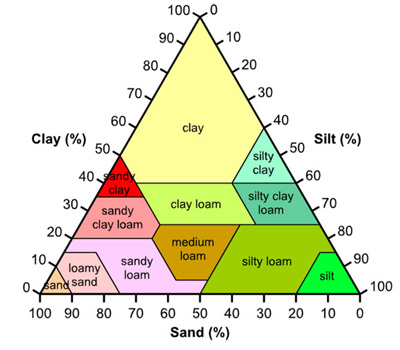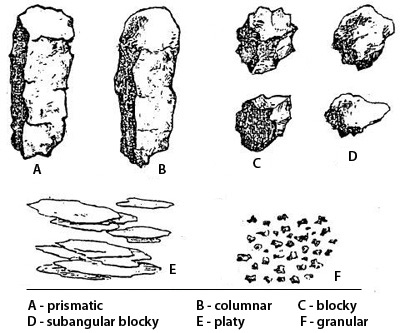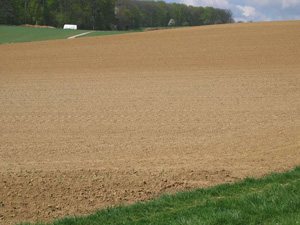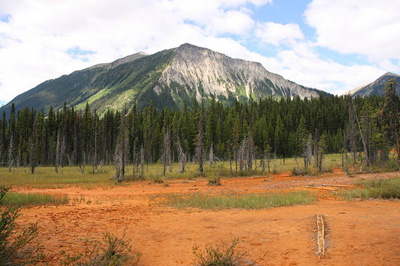Soil Physical Properties
Take that handful of soil from earlier and pack it down in a plastic container so that it is about an inch thick. Now, pour about two tablespoons of water right in the middle and time how long it takes for the water to "seep" in. What did you notice? Did it soak in quickly? Slowly?
To build a home, many builders are required to perform a "land perk" test. This test is basically the same as what you just did—a test to see how quickly the water seeps into the ground. This determines the size of the septic system they can put in the ground, which, in turn, decides the size of home that can be built. The results of the perk test rely heavily on the properties of the soil in that area—porosity is a defining physical property of soil.
We generally divide soil properties into physical and chemical properties. Soil’s physical properties relate the general appearance and behavior where chemical properties have to do with the chemical reactions that take place within the soils. Click through the tabs to learn about some important physical properties of soil.
Soil Texture

Texture is the most important physical property of soil in terms of the nutrients that soil provides to plants. Texture describes the relative percentages of sand, silt, and clay-sized particles in a soil. Soils dominated by sand are coarse-textured, while those dominated by clay are fine-textured. The soil texture triangle that you see in this image is a tool used to name a soil based on its texture. For example, a soil that has 50% sand, 25% clay, and 25% silt is called a sandy clay loam soil. Loam is a term used to indicate a soil that has a mixture of sand, silt, and clay. Clay generally has a greater nutrient-holding capacity than sand and silt. Some clay in your soil texture is important for soil fertility. However, clay also has very slow drainage; it holds water so tightly that plants may not be able to access it. Conversely, very sandy soil is low in both nutrients and water because sand has a little ability to hold either. Therefore, the best soils are loam soils that contain the right balance and mixture of sand, silt and clay so that both water and nutrients are available to plants.
Soil Structure

Soil structure describes how soil particles clump together. Clumps of soil are called peds. They are made of individual soil particles that have been aggregated together. They are not consolidated like a rock and can be easily broken apart if crushed, but they still display some sort of clumping or aggregation, usually in one of the characteristic shapes shown in the picture. Some soils naturally form peds better than others and thus have better developed soil structure than others. For example, sandy soils have poor soil structure because their individual particles do not stick together very well. Loamy and clay soils develop better soil structure because clay tends to add stickiness to a soil. A few examples of soil structures are shown here, including examples, such as granular and subangular blocky.
Bulk Density

Bulk density is the measure of a soil’s mass per unit of volume. Some soils are much lighter than others. Humus-rich soils, for example, are relatively light and have a low bulk density. Clay-rich soils, however, are heavier with higher bulk densities. The bulk density of solid rock is usually around 2.65 g/cm3. The bulk density of a typical loam soil is about 1.0 to 1.6 g/cm3. A soil very high in humus can have a bulk density of less than 1.0 g/cm3.
Porosity and Permeability

Porosity describes the amount of open space between individual soil particles in a given soil. It is inversely related to bulk density. In other words, when bulk density is high, porosity is small and vice versa. Permeability describes the degree of connectivity between soil pores. In the picture on the left, you see some open pores between soil particles. The soil on the right also has open pore spaces, but it has a variety of particle sizes and the pore spaces are smaller. Which soil do you think has the greater permeability? The one on the left has greater permeability because it has larger channels through which water can flow. Water would have a more convoluted path in the soil on the right because large pore spaces are not very well connected.
Color

Soil color often shows the minerals that are found in the soil. These minerals are dependent on the soil’s parent material and the types of weathering the soil has gone through. Reddish and yellowish soils are usually high in oxidized iron. Organic matter gives soil a dark black or brown color. Soils that stay saturated with water, and that are thus under anaerobic (oxygen-free) conditions, sometimes develop a bluish-grey color.